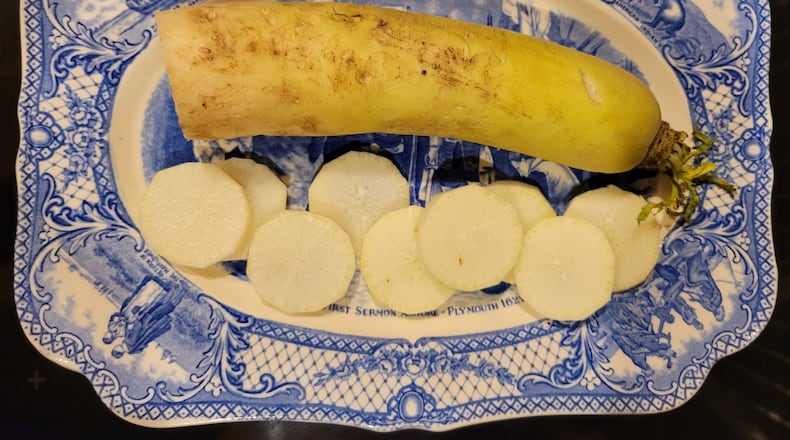Like a red radish, daikon is best consumed raw. Dice it for inclusion in a tossed salad based on lettuce available even this time of year from one of our local growers. Or slice it for dipping in local hummus.
Alternatively, shred daikon in a mini-chopper or by hand and use it to make slaw instead of or in addition to cabbage. It marries well with a vinegar-based dressing or sauce, for example 2 parts olive oil to 1 part balsamic vinegar, or 2 parts mayonnaise to 1 part Dijon mustard.
If you prefer to cook daikon, the best bet is roasting. One option is to cut a daikon into sticks like French fries, coat with some grapeseed oil, ground ginger, and soy sauce, add some hot pepper sauce if you like that sort of thing, and roast at 400 for around 20 minutes.
A second roasting option is to cut a daikon into disks, also cut up carrots and bell peppers, drizzle with olive oil and garlic, and again roast at 400 for around 20 minutes.
In North America, daikon is primarily grown as a fallow crop, though the leaves are sometimes used as animal fodder. The U.S. Department of Agriculture calls daikon oilseed or tillage radish.
The U.S.D.A. recommends leaving the long thick root unharvested in order to minimize soil compaction. When the large root decays, a large cavity is left in the soil, making it easier for the following year’s crop, such as potato, to bore deeper into the soil.
By not harvesting daikon, we’re missing out on a treat. If you like our familiar small red globe radish, you’ll love daikon. It does everything the small red radish does, plus more. As a root crop, daikon needs to be peeled like a carrot.
Do you have young ones who won’t eat their vegetables? Tell them the daikon is actually a unicorn horn.
If they need proof, look online for a photo of a unicorn horn on display at the Cluny Museum National Museum of the Middle Ages in Paris.
Cluny houses six tapestries woven around 1500 of a unicorn and a lady depicting each of the six senses. In addition to the five senses we know – touch, taste, smell, hearing, sight – the medievalists identified a sixth sense – heart.
If the young one retorts that unicorns are mythical, your rejoinder is that the Cluny Museum’s unicorn horn is probably in all likelihood the tusk of a narwhal. It still looks like a daikon.
Jennifer Bayne was horrified when I told her I was writing this. She considers daikon too strong-flavored for kids.
MOON Co-op is Oxford’s consumer-owned full-service grocery, featuring natural, local, organic, sustainable, and Earth-friendly products. The store, located at 516 S. Locust St. in Oxford, is open to the public every day. Visit online at www.mooncoop.coop.
About the Author
